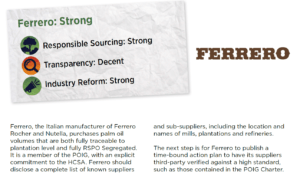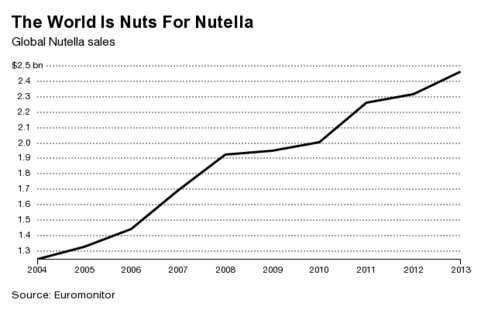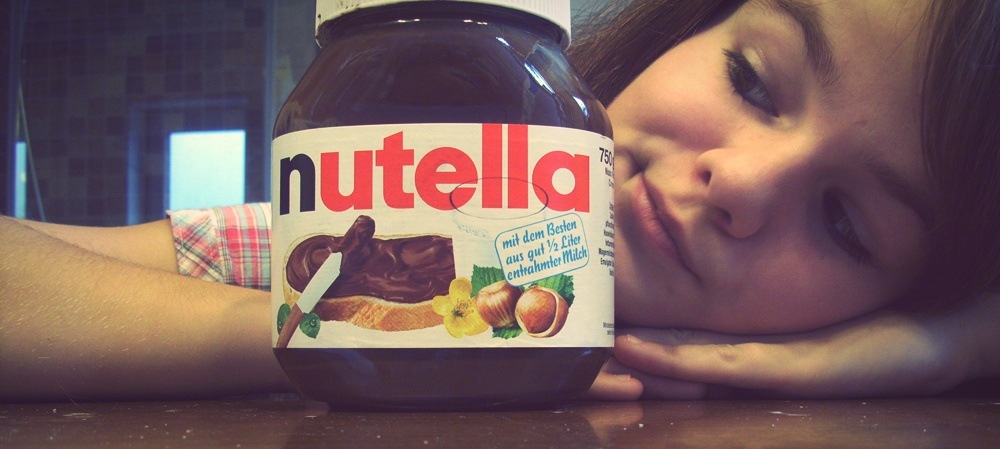Nutella no more?

A jar if Nutella is sold every 2.5 seconds. Will Ferrero be an environmental villain, hero or victim in their attempt to satisfy this growing global appetite?
“We should stop eating Nutella”
In June 2015, France’s ecology minister, Segolene Royal, urged the public to boycott Nutella in a bid to curb Ferrero’s contribution to climate change. Royal argued, rightly, that unsustainable palm oil agricultural practices contributed to deforestation and global warming. Ferrero produced Nutella, and Nutella contains palm oil (1). Around the world, Nutella devotees clutched their chocolate spread laden spoons in horror.
But they needn’t have been concerned. Because, in fact, Ferrero has in recent years become a somewhat poster child for sustainable palm oil sourcing. In 2013, the group launched the ‘Ferrero Palm Oil Charter’ (Exhibit 1), in partnership with the NGO TFT, and committed to ensuring 100% of its palm oil was sourced from suppliers are compliant with its 10 criteria (2). TFT teams work with suppliers engaged in time-bound action plans, and consumers are kept informed through bi-annual, publicly available reports (3). This charter goes beyond environmental RSPO certification which it achieved for 100% of its supply in 2015. Greenpeace lauded their actions, celebrating Ferrero as “a model for the rest of the industry to follow” (Exhibit 2).
Royal’s comments were quickly and widely denounced in the press; she responded to criticism by tweeting her “one thousand apologies” (4).


Ferrero looking out for itself
Ferrero’s concern with sustainable sourcing is driven by self-interest. With hazelnut and cocoa as key ingredients, which have yields sensitive to variability in weather and water, Nutella is a likely culinary casualty of climate change.
For hazelnuts, this is further compounded by its geographically-concentrated cultivation: over 70% of global supply is grown in Turkey. The risk that this single major source poses, with the increasing regularity of extreme weather caused by global warming (6), was demonstrated in 2014 when a period of severe frost in March and a freak hailstorm reduced hazelnut output by more than 30%. The ensuing shortage caused a 60% surge in hazelnut prices (Exhibit 3), with an inevitable knock-on cost impact for Ferrero (7, 8).

To safeguard its future hazelnut supply, Ferrero acquired Oltan, Turkey’s largest hazelnut producer (8, 9). While this acquisition guarantees the supply of hazelnuts available in any given year, this in itself does not protect Ferrero against future hazelnut shortages. Ferrero bolstered this by establishing 6 hazelnut agricultural companies in Chile, Argentina, South Africa, Georgia, Australia and Serbia to diversify the supply risk from extreme weather in any one geography (2).
Unlike palm oil, Ferrero is still a long way off achieving 100% sustainable sourcing in cocoa and hazelnuts. Only 40% of Ferrero’s cocoa supply was certified sustainable in 2013/4 through its partners (UTZ, Rainforest Alliance). Promisingly, however, the group are embarking on a roadmap to achieve 100% sustainability by 2020. For hazelnuts, disappointingly, Ferrero has not committed itself to any sustainability targets. Its goal is simply to achieve 100% traceability by 2020; this was only 5% in 2014 (2). In 2015, Ferrero launched the “Ferrero Hazelnut Award Contest” which granted €160,000 to three research groups who proposed the best (innovative and applicable) projects promoting hazelnut agricultural sustainability (10); the impact of these projects to date is unknown.
A Nutella-filled future?
So then is Ferrero really doing enough to preserve the future of our favourite chocolate spread?
While sustainable agriculture is a first, important step towards limiting impact on climate change (as explained by the World Bank), given the serious threat to Nutella’s cornerstone ingredients, it is unclear whether Ferrero is as proactively collaborating with technical experts on climate modelling and agricultural innovation as it should. To ensure future sustainability, they should be mandating that suppliers, including in-house Oltan, are continually working towards a better understanding of how a crop planted today will need to adapt to the changing rainfall patterns as well as higher temperatures during its productive lifespan. And that they are complementarily innovating in soil fertility management and rehabilitation techniques to cater to this. Competitors (Nestle, Lindt & Sprungli, Mondelez) have all invested in CocoaAction, an umbrella initiative which includes this imperative (11).
As climates more dramatically change going forward, Ferrero should also plan for the likelihood that their agricultural products may need to be cultivated in other geographies, as temperatures elsewhere become more appropriate and temperatures in current locales less so.
Finally, more radically, could Ferrero consider experimenting with raw material substitutes, such as Carob, a drought-resistant pseudo-cocoa crop (12), in place of cocoa? Or is the Nutella taste too sacred to experiment with?
As the world continues to go ‘nuts for Nutella’ (Exhibit 4), let’s hope Ferrero faces up to the challenge of sustainably satisfying its increasing fan base – for the good of the environment, and our pancakes.

Word count: 773 words

References
- AFP, “Stop eating Nutella and save the forests, urges French ecology minister”, The Guardian, June 16, 2015, https://www.theguardian.com/environment/2015/jun/17/stop-eating-nutella-and-save-the-forests-urges-french-ecology-minister, accessed November 3, 2016.
- 2014 Corporate Social Responsibility Report – Sharing Values to Create Value. Alba, Italy: Ferrero, 2015.
- “Ferrero Palm Oil Progress Report.” https://www.ferrero.com/group-news/Ferrero-palm-oil-progress-report—November-2014/?searchcat=&searchdate=2014-11, accessed November 3, 2016.
- Segolene Royal (@RoyalSegolene), “Mille excuses pour la polemique sur le #Nutella. D’accord pour mettre en valeur les progres” Twitter post, 17 June 2015, 10:31 a.m., https://twitter.com/RoyalSegolene?ref_src=twsrc%5Etfw
- Greenpeace, “Cutting Deforestation out of the Palm Oil Supply Chain – Company Scorecard 2016”, downloaded from Greenpeace website, http://www.greenpeace.org/international/Global/international/publications/forests/2016/gp_IND_PalmScorecard_FINAL.pdf, accessed November 3, 2016
- US Environmental Protection Agency. “Understanding the Link Between Climate Change and Extreme Weather”, https://www.epa.gov/climate-change-science/understanding-link-between-climate-change-and-extreme-weather, accessed November 3, 2016
- Terazono, Emiko, “High hazelnut prices torment confectioners”, FT.com, August 13, 2014, accessed November 3, 2016 (via ProQuest ABI/INFORM)
- Wong, Vanessa, “Nutella Hogs Hazelnuts to Meet the World’s Insatiable Craving for Chocolaty Goodness “, Bloomberg, August 15, 2014, http://www.bloomberg.com/news/articles/2014-08-14/nutella-buys-hazelnut-supplier-to-protect-against-worldwide-shortage, accessed November 3, 2016.
- Anzolin, Elisa, “Nutella maker Ferrero buys Turkish hazelnut company Oltan”, Reuters, July 16, 2014, http://www.reuters.com/article/us-ferrero-hazelnuts-turkey-idUSKBN0FL2CY20140716, accessed November 3, 2016.
- Ferrero, “Ferrero Hazelnut Award Contest”, https://www.hazelnutcompany.ferrero.com/Ferrero-Hazelnut-Award-Contest/, accessed November 3, 2016
- World Cocoa Foundation, “Cocoa Action Annual Report 2015”, downloaded from World Cocoa Foundation website, http://www.worldcocoafoundation.org/wp-content/uploads/CocoaAction-Annual-Report-2015-English.pdf, accessed November 3, 2016
- Baltozi, P, et al, “Low Water–Demand Plants for Landscaping and Agricultural Cultivations – A Review Regarding Local Species of Epirus/Greece and Apulia/Italy.” Elsevier Vol. 4 p250-260, 2015. http://www.sciencedirect.com/science/article/pii/S2210784315000923, accessed November 3, 2016



As a loyal Nutella consumer, this article really resonated with me! I agree that from a business perspective Ferrero could be doing more to ensure the future of its superstar product, particularly in terms of forecasting the impact of climate change on all its key raw materials and developing plans to specifically address these climate-related risks. As a citizen of the world though, I’m more concerned about how Ferrero is changing its practices to become more environmentally sustainable, so that I can continue to coat everything I eat with Nutella without feeling terrible about the environmental impact I’m having. It is extremely discouraging that Ferrero has not made any sustainability pledges in terms of its hazelnut sourcing, especially as the company purchases around ¼ of the world’s hazelnut crop. I was additionally concerned about figures like the water footprint of hazelnuts. Per this Huffington post article from 2014 (http://www.huffingtonpost.com/2014/10/13/food-water-footprint_n_5952862.html), hazelnuts have the most favorable water footprint out of all the nuts at 1,260 gallons of water required to produce 1 pound – but that number is still astoundingly large, especially when compared to other categories of food (e.g., potatoes at 34 gallons/lb, rice at 222 gallons/lb, chicken at 518 gallons/pound). I wonder if Ferrero can invest in research to develop more water-efficient hazelnut production.
When reading this article, I could not help but draw similarities between Nutella’s reliance on hazelnuts and IKEA’s reliance on wood. In particular, one of the issues IKEA faced in the case we read was whether or not it should increase the amount of forest it leases, in order to better control its supply chain. When weighing the pros and cons of that decision, one of the factors that IKEA took into account was the additional overhead costs that would be incurred by entering the timber business. I am curious to know what additional costs Nutella incurred by entering the hazelnut business (both through acquisition and through opening additional agricultural centers). This is radically different from their previous buyer-supplier relationship, and likely resulted in many fixed costs. I suspect these fixed costs could be part of the reason that Ferrero is not yet focused on sustainable hazelnut growing practices, as additional costs from those sustainable process could further damage their bottom line.
Although I resonate with the comments above, I also wonder what the broader environmental impact of hazelnut manufacturing has on climate change. Outside of protecting their own supply chain, is the investment in more sustainable hazelnut production really the best place Ferraro can spend to thwart climate change? The post above mentions Hazlenuts are already more favorable with respect to water footprint than other nuts. I also wonder what the risk to the supply chain really is now that Ferraro has diversified the locations of manufacturing. Can they diversify more to reduce supply chain risk? Are there more locations that will become viable for manufacturing as climate changes? While I respect that any move toward sustainability is helpful to the environment, I wonder if the scale and impact from improving hazelnut production is relevant beyond risk aversion for Ferraro’s sales.
I love Nutella! This was a very enlightening post about the environmental impact of a treat that many of us adore. I remember the public discussion about Nutella’s sourcing of palm oil, but did not realize that Ferrero had taken such big steps to make its palm oil sourcing sustainable. I thought that its strategy of partnering with the NGO TFT was particularly interesting as a potential model (partnership between business and non-profit sector) for other businesses to follow to confront climate change. It is disappointing that Ferrero has not made as aggressive commitments to sustainability in sourcing its other major ingredients. In this regard, maybe Segolene Royal was somewhat justified in her critique of the product.
Well sc635, let me start off by saying that this is a superbly written article and quite the delicious topic. I’m glad to hear that Nutella is on the forefront of sustainable palm oil sourcing. It seems like it was a good move by the company to acquire the hazelnut producer in Turkey and benefit from vertical integration. I wonder however, given the recent political instability of the Turkish government, if this was the smartest business move and if the producer has any risk of becoming nationalized. I’m sure that Nutella’s move to acquire more hazelnut producers around the world would help diversify some of this procurement risk.
Deliciously controversial topic, Saskia! I did not know that Ferrero was such a large global consumer of hazelnuts. Any idea what percentage of the global demand they represent? It seems like they are a large enough consumer to be actually materially increase global consumption of hazelnut.
I agree with you that Ferrero seems to be “looking out for itself” rather than truly being environmentally sustainable. It seems incongruent that the company abides by the vigorous principles of the palm oil charter to source from compliant suppliers yet only aims to achieve 100% traceability by 2020. This reminds me of the Ikea case we just did where a company that serves as a major source of demand for a product should take steps to ensure the sustainability of that product. I wonder if there is a hazelnut substitute that consumers can adapt to, such as an artificial flavoring or even another type of nut. There are startups like Gingko Bioworks which are using technology to “engineer” flavors and scents (http://blogs.wsj.com/venturecapital/2015/03/18/ginkgo-bioworks-raises-9m-to-engineer-food-flavors-fragrances/); Gingko engineers microbes in yeasts to imitate tastes and scents could have long-term positive effects for how we sustainably flavor our food. Changing the product may hurt some fans in the short-term but more environmentally-conscious millennial consumers will be more open the social message.